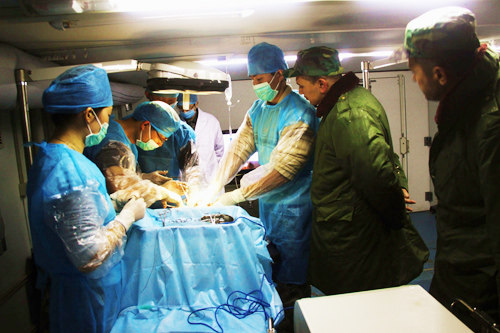 |
|
ZERO-DISTANCE OBSERVATION: Foreign officers observing the PLA's "Victory 2009" military exercise visit a field hospital to watch a simulated surgery (LIU FENGAN) |
Military analysts believe that conducting joint military exercises is an important measure that will allow the PLA to increase its transparency and ability to deal with the world's new strategic environment. Joint military maneuvers have helped the PLA to exchange opinions on strategic concepts with foreign forces. By participating in joint drills, Chinese military personnel have communicated with their foreign counterparts, which helps them build mutual understanding and trust. Chinese military personnel also learn from the experience of their foreign counterparts, which is conducive to boosting the PLA's technical and tactical levels and helps propel its modernization drive.
Besides carrying out joint war games, the PLA has also been holding more and more training exercises with foreign troops. Between 2007 and 2009, the PLA participated in five joint trainings with troops from Thailand, India, Singapore and Mongolia.
In 2010 alone, Chinese military forces took part in five joint trainings with their counterparts from Pakistan, Thailand, Turkey and Romania and three of these training were held in China.
"Friendship 2010" China-Pakistan antiterrorism joint training was launched on July 9, 2010 in China's Yinchuan City. A total of 226 troops from the two countries' special forces participated in the drills, which involved fighter-bombers, freighters, transport helicopters and armed helicopters. The training included six themes, namely long-distance delivery, reconnaissance and surveillance, blockage, precision strikes, hostage rescue and search for terrorists. The exercise adopted a new mixed grouping model, which allowed the two countries' special forces to better learn from each other.
On October 8, 2010, a joint Thai-Chinese marine antiterror training exercise codenamed "Strike 2010" was launched in Guilin of southwest China's Guangxi Zhuang Autonomous Region. Sixty Chinese marines and 60 Thai marines participated in the drill. This was the first time the marines of the PLA navy participated in joint training with foreign troops.
Zheng Qin, deputy commander of the PLA's Guangzhou Military Area Command, who observed the exercise, told the media that antiterror operations in cities are particularly difficult and require frequent training for special forces since terrorists are often concealed among ordinary residents. He said that Thai special forces had more field experience and more international training opportunities which made them ideal for Chinese troops to learn from.
Also on October 8, 2010, an assault unit of the PLA kicked off its weeklong joint training with a Turkish army contingent, the first training of its kind between forces from the two countries.
In November 2010, a team from the PLA air force went to Turkey to participate in a joint exercise, which, according to The Washington Post, was the first such drill involving China and a North Atlantic Treaty Organization member country.
Between November 5 and 13, 2010, the Chinese and Romanian armies conducted a joint training codenamed "Friendship Action 2010" in Kunming of southwest China's Yunnan Province. The exercise, which focused on mountain infantry tactics and skills training, was the PLA's first joint exercise with forces from a European country held in China.
Military analysts believe that inviting foreign troops to train in China is a clear sign of the PLA's increasing self-confidence. They believed that the increase in the number of joint trainings with China's neighbors also sheds light on the development of China's security diplomacy.
| 